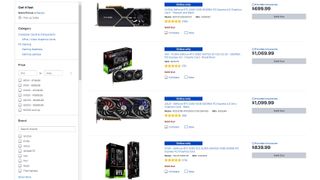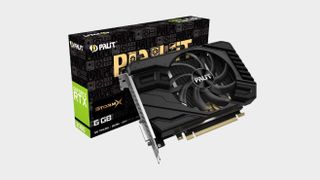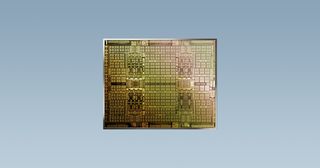All the ways the world is trying to deal with the graphics card shortage and why they won't work
We've collated all the different methods used and proposed for easing the dearth of GPUs for gamers and rated their effectiveness.

With the new AMD Radeon RX 6700 XT stock vanishing in the blink of an eye, like some ethereal graphics card of myth, the issue of GPU stock and the cryptocurrency mining crisis is brought to the fore once more. So let's rate all the different ways people have come up with to get us out of this nightmare situation.
It's all about supply and demand. That hoary old chestnut? Yup. It’s ultimately what the ongoing PC graphics card shortage boils down to. Right now, buying almost any Nvidia GPU is a major headache. As for AMD graphics cards, forget it.
That doesn’t look like changing anytime soon. In the meantime, what‘s the best way to get the very limited supply of GPUs into the hands of actual gamers? Now that’s a question.
Currently, the graphics card supply side is moderate at best. Demand? It’s completely off the scale. According to John Peddie Research (JPR), around 11 million graphics cards were shipped in the final quarter of 2020. Wind back to late 2017 and 2018 for context and you’ll find several successive quarters with over 15 million cards shipped, which is precisely when the crypto-bubble last crashed.
As you might guess, given the near total impossibility of buying one of its new Radeon RX 6000-series boards, it’s AMD that is really struggling with supply. JPR reckons AMD only managed to ship 1.87 million graphics cards in the final quarter of 2020. For comparison, AMD managed to crank out 5.62 million boards in the first quarter of 2018.
Meanwhile, combined demand for GPUs from gamers who have waited years for a really big step up in graphics performance, and cryptocurrency miners who view the things as virtual cash machines, is at an all-time high.
If you’re a purist free marketeer, you might be happy with the way things are going. Let the market dictate prices. With that in mind, our sister site Tom’s Hardware has been tracking GPU sales on eBay and collated some pretty sobering stats.
The biggest gaming news, reviews and hardware deals
Keep up to date with the most important stories and the best deals, as picked by the PC Gamer team.
Prices of Nvidia GeForce RTX 3070 boards are currently running at around $1,200. That’s a graphics card with a recommended price of $500. Prefer a GeForce RTX 3080? It’ll cost you over $2,000 instead of the recommended $700. Even the disappointingly weedy GeForce RTX 3060 commands $800. As for AMD’s Radeon RX 6000 series, the cheapest of those, the Radeon RX 6800 is up around $1,300. It’s painful.
Anyway, the first point to recognise is that GPUs are going to be hard to come by until either production increases dramatically or demand plummets. There’s no avoiding that. And demand will only drop when cryptocurrency mining on the GPU stops being profitable, and that could still be a far off dream.
The question that follows isn’t what is the best way to solve the shortage, it’s whether the problem can be usefully mitigated in any way. Or are we all doomed to days on end hitting refresh on half a dozen retailer websites?

The free market
In other words, the status quo. Let the market decide. Which it has and it’s decided that gamers have to pay a fortune for graphics cards. There are simply so many highly motivated non-gamer customers, mainly people buying GPUs to mine cryptocurrency, that high prices are inevitable.
At the more serious end of the spectrum, those people have the time, resources and technical expertise to make sure they’re at the front of every queue, whether that’s courtesy of making a full time job of watching retailers like a hawk or using bots that do the work for them.
They’re likewise happy to pay well over the recommended retail price so long as the card remains profitable for mining the cryptocurrency du jour. There are plenty of people doing well out of all that, including middle men, scalpers, and miners. But not gamers.

Efficacy rating: 1 / 10
Definitely not working out well for gamers.

Manufacturer queues
Enter EVGA, which has been running a first come, first serve queuing system from its own website for Nvidia GeForce RTX 30 series GPUs since last September. You simply jump onto EVGA’s website, make your choice, sign up to join the queue and wait to be notified when stock becomes available. Simples.
To quote EVGA, "once product is available (and it is your turn to purchase), you will receive a secure email that will allow you to purchase the product that you received a notification for. Please note that you have eight hours to place your order, if your order is not complete within 8 hours, the product will be released back into the queue system. Please note that EVGA Support does not have any information when/if you will receive a notification or your queue number."
It makes sense in theory. If you’re lucky enough to get an allocation, you’ll be paying EVGA’s retail price, not some hideous markup. But like many of these systems, it’s all about the execution. There’s no way of knowing where you are in the queue or how long it might take to get a card. Customer reports are varied. Some claim to have secured a card in just a few weeks. Others that they’re still waiting nearly six months on. Much depends on your location, with EVGA apparently prioritising North America over Europe.
EVGA limits orders of any given GPU to one per household. Problem is, it sells 10 different versions of the GTX 3090 alone. So, any crypto miner remotely interested in bagging a board will simply sign up for all 10. As will gamers who are even half serious. You don’t pay up front, so there’s nothing to be lost. Which is why, reportedly, EVGA is only a few days into the queue for some SKUs, nearly six months after the cards were launched. Anyway, for many chipsets, the queue is massive and it’s already too late to join it if you want a card before the next ice age.

Efficacy rating: 3 / 10
You’re almost certainly already too late

Retailer pre-orders
Several etailers have attempted to implement queuing systems to allow gamers to pre-pay for cards and bag a place in a queue, ready for GPU drops as they arrive in-store.
Paying up front isn’t ideal. But as several etailers would argue, it sorts the serious interest from the passing carpetbaggers. As for how well it works, it all comes down to execution. In the UK, Overclockers.co.uk made the mistake of not limiting the number of pre-orders, resulting in a huge queue which it had little hope of fulfilling. Overclockers has since recommended that customers apply for a refund.
Another popular UK site, Scan.co.uk, also ran a pre-order system but limited those pre-orders to an estimated six-week window. Sounds sensible, but supply has been so limited and so unpredictable, Scan has largely given up on pre-orders.
Where it works, it’s certainly an attractive idea. You pay something resembling the recommended retail price. Sure, you have to wait, but knowing you have a card coming tends to have a cooling effect, discouraging paying over the odds on an impulse.
The problem is that it’s a difficult approach to maintain when supply is so tight and sporadic. There have also been reports of bots snapping up availability, though most websites run countermeasures, such as manually reviewing orders, to prevent or reduce that problem and it’s hard to know exactly how big an issue bots are in this whole debacle.

Efficacy rating: 6 / 10
So long as the bots don’t beat you to it

Retailer lotteries
One of the United States' biggest online retailers, Newegg, has been running an intriguing lottery system known as Newegg Shuffle. You register on the Newegg website and keep your scanners peeled for the announcement of upcoming Shuffles, each of which includes a range of different products that are shortly to be offered for sale.
Each Shuffle involves a time limited window, during which you can choose a product and enter the lottery. A draw is made shortly afterwards. Lottery ‘winners’ then have four hours to finalise their purchase.
It sounds like a decent idea, but customer reports suggest the execution leaves plenty to be desired. For starters, the offered products and pricing aren’t particularly appealing. One recent Shuffle was limited to one Nvidia RTX 3090 SKU for $1,919 and one RTX 3060 option for $539. Yuck.
What’s more, some buyers report apparent bait-and-switch tactics in which the product offered to lottery winners is more expensive than that originally listed. Newegg was also often bundling GPUs with other products, like PC PSUs, in what looked like a fairly cynical attempt to shift some unwanted stock, though recent Shuffles fortunately seem to have reverted to stand alone graphics cards.

Efficacy rating: 6 / 10
Or 4/10 if the bait-and-switch claims are true.

Bring back old GPUs
Here’s a rum solution to the GPU crisis. Resurrect some old boards. Namely the Nvidia GeForce GTX 1050Ti and RTX 2060. Nvidia says these cards were never cancelled, so they can’t actually have been resurrected. But it also didn’t deny that new supplies of these old GPUs had been sent to board partners.
If you’re a first time gaming PC builder, it doesn’t sound like a bad idea. Until you see the pricing. £390 for an RTX 2060, i.e. more than the darn thing was at launch over two years ago? No thanks.

Efficacy rating: 1 / 10
Crazy prices for ancient graphics cards

Cryptocurrency mining limiters
The main reason why demand for GPUs has gotten so very out of control is thanks to cryptocurrency miners, right? So why not somehow hobble the hash rate or speed at which GPUs can mine various crypto coins to make them less appealing or even completely useless?
That’s exactly what Nvidia did for its latest Ampere card, the RTX 3060. "RTX 3060 software drivers are designed to detect specific attributes of the Ethereum cryptocurrency mining algorithm, and limit the hash rate, or cryptocurrency mining efficiency, by around 50 percent," Nvidia says.
Nvidia claims the has limiter can’t be hacked. "End users cannot remove the hash limiter from the driver. There is a secure handshake between the driver, the RTX 3060 silicon, and the BIOS (firmware) that prevents removal of the hash rate limiter."
Problem is, Nvidia then accidentally released a development driver with the limiter removed. The genie is out of the bottle and it can’t go back in. One could argue that this kind of approach is bound to be bypassed eventually. But anything that undermines confidence in the latest GPUs as money printing machines is welcome.
It won’t stop the most determined, but it should give more casual miners pause for thought and thus shave off a little demand. At least it would have if Nvidia hadn’t unloaded a full clip of assault rifle rounds into its own feet.

Efficacy rating: 0 / 10
...as things stand. Pity, because it might have helped

Custom mining graphics card SKUs
Back in February. Nvidia announced a new GeForce CMP or Crypto Mining Processor product line. According to Nvidia, "CMP products — which don’t do graphics — are sold through authorized partners and optimized for the best mining performance and efficiency. They don’t meet the specifications required of a GeForce GPU and, thus, don’t impact the availability of GeForce GPUs to gamers.
"For instance, CMP lacks display outputs, enabling improved airflow while mining so they can be more densely packed. CMPs also have a lower peak core voltage and frequency, which improves mining power efficiency."
Nvidia is offering a range of CMP products, somewhat mirroring the RTX range. It sounds like a good idea. But if our understanding is correct, these are a mix of Turing and Ampere GPUs mounted on simplified boards. They’re not going to help with the underlying problem, which is a shortage of GPUs. Even if CMP boards use custom GPUs, they’ll be vying with gaming cards for the limited manufacturing capacity that’s underlying this whole mess.
Then there's also the fact that a lot of miners will be unhappy about the lack of any potential resale value for the resolutely mining-only cards. GPUs used for mining often find their way into the second hand market, giving miners a chance to recoup some of the initial investment if the market and profitability dips, or they upgrade their systems. With no outputs on them there is no resale value for CMP card.

Efficacy rating: 2 / 10
Hard to see how this helps the root problem

Manufacturer auctions
That’s already covered by Ebay, isn’t it? Not quite. At least, not in terms of how graphics cards are initially sold. John Carmack of Doom fame, and latterly AI and Aerospace brainbox, has mooted the idea of card makers themselves auctioning product direct to customers.
Given shortages and speculators on things like 3090 GPUs and new consoles, it seems like we really would be better off with a transparent auction system directly from the manufacturers and a more efficient market. The world of sales channels prevented that in the past, but we \February 19, 2021
It certainly has the advantage of cutting out middlemen and scalpers. As Carmack says, “there would be much indignation at reported prices out of the gate, but removing intermediaries should net out better for consumers in the end.”
This isn’t going to make for really cheap GPUs. But it would at least be transparent. The problem is that the level at which graphics cards stop being cost effective for crypto might be so high as to effectively exclude nearly all gamers. But there’s only one way to find out...

Efficacy rating: 6 / 10
Probably about as good as it’s going to get until supply increases or demand subsides

Jeremy has been writing about technology and PCs since the 90nm Netburst era (Google it!) and enjoys nothing more than a serious dissertation on the finer points of monitor input lag and overshoot followed by a forensic examination of advanced lithography. Or maybe he just likes machines that go “ping!” He also has a thing for tennis and cars.
Most Popular


